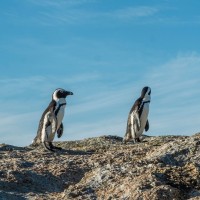- Overview
- Full Itinerary
- Extensions
- Photo Gallery
- Costing
- Travel Details
- Trip Reports
- Guide
- Know Before You Go
- Other Trips You May Like
Join Naturalist Journeys on this Tanzania wildlife safari to see the splendor of East African birds alongside iconic animals like Elephant, Wildebeest, Common Zebra, Buffalo, Impala, Gazelle, Hartebeest, Eland, Lion, Cheetah, Leopard, Spotted Hyena, Vervet Monkey, Baboon, and so many more. This fall departure is timed for excellent wildlife watching and birding and we've kept it under two weeks, with your budget and time away from home in mind. This year we've added an additional night in the Serengeti and a scenic charter flight back to Arusha to avoid a long and dusty travel day at the end of your safari.
We begin in Arusha, followed by time at Arusha and Lake Manyara National Parks. Explore at Oldupai Gorge and the wildlife heavy Ngorongoro Crater, and witness the splendor of Tarangire National Park, perched on a principal migration corridor into the Serengeti; this is what wildlife documentaries are made of.
Throughout our exploration, learn about the Great Rift Valley and the whole area’s fascinating geology. Central to our journey is time in the Serengeti eco-system. With its endless plains, the Serengeti is the heart and soul of our African wilderness experience.




Tour Highlights
- Witness spectacular concentrations of wildlife at seasonally shrinking watering holes; watch interactions between predator and prey
- Discover Lake Manyara National Park, home to tree climbing Lion, enormous tusked Elephant, Bushbuck, Giraffe, Zebra, Buffalo, Leopard, Impala, and more
- Enjoy two nights on the rim of the Ngorongoro Crater and absorb the view, then venture into the crater with its teeming wildlife
- Witness the rare Black Rhino in Ngorongoro Crater, as well as many bull Elephant
- Spend four nights at two picturesque lodges at Serengeti National Park
- Search for fascinating birds in the Serengeti, like Hamerkop, Saddle-billed and African Openbill Storks, Lappet-faced Vulture, and Tawny and Martial Eagles
- Find big cats and watch their behavior; in the last years we have seen all the big cats, plus in some years, Serval and Caracal
- Visit Oldupai Gorge with a local guide, and learn about the sequence of important anthropological finds
- Opt for a sunrise hot air balloon ride over the Serengeti — wow!
- Relax for two nights in a lovely lodge at Tarangire National Park




Trip Itinerary
Itineraries are guidelines; variations in itinerary may occur to account for weather, road conditions, closures, etc. and to maximize your experience.
Sat., Nov. 7* Arrival in Arusha | Kilimanjaro International Airport
Many of the major carriers fly to Arusha, Tanzania, through Johannesburg, Nairobi, Amsterdam, Doha, and Dubai. Since flights come in throughout the day, we have not set up any activities so you can rest or explore as your energies dictate. Our hotel is convenient to the airport and has African-style architecture, rooms with cozy décor, and is great for birders, with mature trees and plantings and views of Mt. Meru and Kilimanjaro. There is a pool, an exercise room, restaurant, and bar facilities.
Accommodations at the Airport Planet Lodge (D)
*Please note that to arrive today, you will need to depart the USA a day or two in advance according to your flight route. If you wish to arrive earlier to rest up or explore Arusha a bit, we can help with arrangements.
Sun., Nov. 8 Full Day in Arusha National Park
The enthusiasm for seeing such abundant birds and wildlife in this lovely park on the shoulder of Mt. Meru was so high on past tours that we added it into our safari as a great way to begin. In 4WD vehicles we explore forests and lakes to see a host of wildlife. We may even walk with ranger guides to see some of the wildlife up close. Warthog, Giraffe, Impala, Zebra, several species of monkeys, and a host of birds, including Greater and Lesser Flamingoes are all possible. We take a picnic lunch with us and make the most of the day.
Accommodations at Airport Planet Lodge (B,L,D)
Mon., Nov. 9 Rift Valley to Tarangire NP | Tarangire Safari Lodge
This morning we make our way to Tarangire National Park, arriving at our lodge before lunch. We start seeing a host of birds and mammals at the park gate, entering a wonderland created by deep red soils and fanciful Baobab trees. At the park gate, Yellow-collared Lovebird, Red-chested Cuckoo, and Pearl-spotted Owlet may be among the welcoming committee. Tarangire is more lush than other places on our trip and animals abound. This is the park where we typically see the largest Elephant herds, often with lots of babies, which are adorable to watch. There are quite a few new bird species for us here, and a number of scenic loop game drives.
Our lodging is on a ridgeline with a fine view of the Tarangire River. Hornbills try to steal our happy hour sunset snacks as we watch herds of grazing mammals come down to drink. With luck, a Pearl-spotted Owlet calls and signals its perch, or attracts colorful songbirds to mob it. Yellow-collared Lovebirds roost among the large trees that stand over our comfortable tented accommodations.
Accommodations at Tarangire Safari Lodge (B,L,D)
Tues., Nov. 10 Tarangire National Park | Night Drive
The Tarangire Safari Lodge not only has great views, it is perched on a principal migration corridor into the Serengeti, about 100 miles from Arusha. Our safari routes take us through ancient boulders and baobab and fig trees, a truly stunning landscape.
Because of varied habitats, Tarangire is a bird lover’s paradise, home to 550 species, the most breeding species in one habitat anywhere in the world. Lush marshes are home to bishops, queleas, and whydahs. Birds of prey abound and the endemic Ashy Starling becomes an easy find.
In Tarangire, we expect to see many Elephant herds and other wildlife like Wildebeest, Common Zebra, Buffalo, several mongoose species, Impala, Gazelle, Hartebeest, Eland, Lion, Cheetah, Leopard, Spotted Hyena, Vervet Monkey, Baboon, and many more. No two days are alike on safari, but every day holds tremendous wildlife viewing, often at close range in this lush and fanciful landscape.
The bird life in Tarangire includes many species associated with the trees, including woodpeckers, barbets, sandgrouse, and numerous songbirds. Red-and-yellow Barbet is common, as are Northern Red-billed Hornbill.
We cap off our stay here with a guided night drive with an experienced lodge guide who reveals some impressive night birds including nightjars, several possible species of owls, Hueglin’s Courser, and with luck the very range restricted Bronze-winged Courser.
Accommodations at Tarangire Safari Lodge (B,L,D)
Wed., Nov. 11 Tarangire NP | Lake Manyara NP | Ngorongoro Highlands
We depart after breakfast, driving about an hour or so to the Great Rift Valley and one of its signature parks, Lake Manyara. Lake Manyara National Park holds one of the region’s Great Rift Valley lakes. In recent years water levels have been rising, so our access is more limited than in years past, but a drive through still allows us to see a good number of birds and wildlife. We hope to see Elephant, Bushbuck, Giraffe, Zebra, Hippo, Buffalo, Impala, and other mammals. Lions and Leopards are both possible, and birds of prey abound. We learn more about the area’s geology from the Mto Wa Mbu escarpment, from which we overlook the Rift Valley and the Manyara Soda Lake.
Manyara is a large alkaline lake and can attract large numbers of Lesser Flamingo and other waterbirds. The lake and wetlands teem with species, including a number of shorebirds, Pied Kingfisher, Hamerkop, African Fish Eagle, African Spoonbill, Great White Pelican, Lesser Kestrel, Eastern Crested Guineafowl, a variety of hornbills, woodpeckers, and other species.
We have lunch in this area, and in the afternoon continue up in elevation on a scenic drive to reach Ngorongoro Crater in the late afternoon. From the rim, we witness a landscape that is spectacular to view from above and below. Your first view from the rim down into this fabled crater is unforgettable! Our lodge is a maze of rock and timbers that blends in perfectly with the rim environment. Your rooms have a patio facing the crater. Maasai villagers bring their beautiful beadwork and provide evening dancing and showcase feats of acrobatics.
Accommodations at Ngorongoro Serena Lodge (B,L,D)
Thurs., Nov. 12 Full Day in Spectacular Ngorongoro Crater
Early this morning we descend into the crater, taking a picnic lunch. We want to make the most of this wildlife and birding hotspot! The Ngorongoro Crater and the Ngorongoro Conservation Area are, without a doubt, some of the most beautiful parts of Tanzania, steeped in history and teeming with wildlife.
At 1600 meters (approximately 5200 ft.) above sea level, the bottom of the Crater is extensive, measuring 265 km (102 miles) square. It is dotted with watering holes and offers shelter to almost 30,000 individual animals in an area naturally enclosed by the slopes of the volcano. It is hard to find this density of mixed mammal species anywhere else in the world. The bird life is largely seasonal and is also affected by the ratio of soda and fresh water on the caldera floor. Expect species such as Hildebrandt’s Francolin, endangered Grey Crowned-Crane, Fan-tailed Widowbird, Lynes’s Cisticola, Pied Avocet, Yellow-throated Sandgrouse, Black-bellied Bustard, Kori Bustard, Secretarybird, Rosy-breasted Longclaw, Lesser Flamingo, Greater Flamingo, Chestnut-banded Plover, and Rufous-tailed Weaver. We observe the behavior of the abundant wildlife: Lion, Zebra, Hippo, Buffalo, Warthog, Eland, and even Dung Beetle are just a few. Considerable research has been done at Ngorongoro and we relate this as we drive. The crater’s Elephant are, strangely, mainly bulls. There are also a small number of rare Black Rhino.
We stay in the crater until mid-afternoon, then head back to our lovely hotel on the rim. Those that wish to keep birding can enjoy some of the mountain species, such as Black-fronted Bush-Shrike, Oriole Finch, Schalow’s Turaco, Hunter’s Cisticola, Bar-throated Apalis, Red-collared Widowbird, Rameron Pigeon, White-eyed Slaty Flycatcher, and others right on the hotel’s grounds.
Accommodations at Ngorongoro Serena Lodge (B,L,D)
Fri., Nov. 13 Oldupai Gorge | On to the Fabled Serengeti National Park | Gol Plains
We leave the highlands today, and descend to the fabled Serengeti Plains. Along our route, we enjoy a picnic lunch and a visit to the world-famous Oldupai Gorge, which is famous for the study of human evolution and one of the most significant archaeological sites in the world. A local guide helps us understand the sequence of important finds here. This is an arid area, with fabulous scenery, geology, and colorful bird species, in addition to its renowned history. A recently-expanded museum here has excellent exhibits and we take a short drive down into the gorge for a different perspective. Rock Kestrel may be flying about and a number of small songbirds frequent the grounds.
The Serengeti boasts a unique combination of diverse habitats, enabling it to support species of large herbivores, as well as birds. Its landscape includes open grass plains, savannah with scattered acacia trees in the center, wooded grassland, and black clay plains. Small rivers and swamps are scattered throughout. Kopjes are scenic knolls of granite and gneiss outcroppings, great for birds of prey and mammalian predators that use them for resting, nesting, and dens; they are also great for seeing smaller mammals.
We spend two nights each at two locations within this large and outstanding park. The Gol Plains include a small mountain range and is one of the park’s most scenic areas, with abundant kopjes that invite exploration. Light plays on the mountains as dusk approaches, creating beautiful sunsets ahead of our gracious dinners.
Accommodations at Mawe Camp (B,L,D)
Sat., Nov. 14 Serengeti | Gol Plains
Abundant grassland in this section of the park attracts Thomson’s Gazelle and their main predator, the Cheetah. Searching for them we feel like we are in a giant rock garden, with intrigue around every turn. We also find Grant’s Gazelle and in November, it’s quite likely the year-round Wildebeest migration is focused here, before heading to Ndutu for calving later in the year. Stately Giraffe grace the plains, and at waterholes we find animals congregating, and watch the antics of Hippo. Birds are plentiful and we hope to find Southern Ground Hornbill, Kori Bustard, various birds of prey and some of the smaller species such as larks, pipits, waxbills, wheatears, and weavers.
We enjoy a morning and afternoon game drive, with a mix of birding and wildlife sightings and return midday to enjoy the delights of camp. This is an intimate camp with just 12 tents, all with private bath and African furnishings. There is a central bar and restaurant and sitting area, and this camp features WiFi if you can’t wait to post or send all your great photos. Views of the savanna and a local river are captivating. We enjoy this part of the park as it is less-visited, and has been a good spot to look for smaller cats such as Serval.
Accommodations Mawe Camp (B,L,D)
Sun., Nov. 15 – Tues., Nov. 17 Three Days in Serengeti Central Plains | Mukaone Camp
After an early breakfast, we head out with our gear, doing a slow wildlife and birding drive to our next camp in the Central Serengeti. This part of the park has hosted numerous biological studies on ecosystem function and predator-prey relationships. It holds ecological richness, and healthy numbers of predators, including Lion, Leopard, Black-backed Jackal, and smaller cats as well.
Serengeti National Park is undoubtedly the best-known wildlife sanctuary in the world, unequalled in its natural beauty and scientific value. With great concentrations of Wildebeest, Thomson’s Gazelle, Zebra, and many other herbivores, Serengeti forms the greatest view of plains game in Africa and has long been a natural classroom for wildlife biologists, many of whom reside here for years. The visitor center has excellent displays to highlight its iconic wildlife spectacle, the annual Serengeti migration.
Birding is also legendary in the Serengeti, and in between mammal sightings we find dozens of species! Over 500 species have been recorded, with 53 birds of prey, Secretarybird among them. Some of the memorable species include colorful Saddle-billed Stork, African Openbill Stork, Lappet-faced Vulture, Tawny and Martial Eagles, Kori Bustard, Meyer’s Parrot, Black Coucal, Swahili Sparrow, Verreaux’s Eagle-Owl, Malachite and African Pygmy Kingfishers, Rosy-breasted Longclaw, Chinspot Batis, Fork-tailed Drongo, Beautiful Sunbird, Golden-breasted Bunting, and so many more!
While in the Serengeti, we can arrange a hot-air balloon ride for you (an additional cost), timed to watch the sun rise as you drift over the plains, filled at this time of year with wildlife—this is pretty wonderful!
Accommodations for three nights at Tukaone Camp (B,L,D)
Wed., Nov. 18 Flight back to Arusha from the Serengeti Central Plains | Final Lunch | Departures
It’s hard to believe our grand adventure is coming to a close, but today we take a scenic flight back to Arusha so that you can connect with flights homeward. Most flights leave at or around midnight, but if you have a morning flight or just want to stay on and rest up before travel, we can book you an extra night to go out the next day (additional cost). We do a game drive in the morning, fly from the airstrip near the park’s visitor center and lunch at the Airport Planet Lodge, where some of you may have items stored. You have a chance to repack and get ready to fly. (B,L)
Nairobi & Amboseli National Parks Pre-Tour Extension
Itineraries are guidelines; variations in itinerary may occur to account for weather, road conditions, closures, etc. and to maximize your experience.
Mon., Nov. 2: Nairobi Arrivals
Please plan to arrive today into Nairobi at your leisure. Upon arrival, rest up or enjoy birding on the grounds. Then enjoy a patio dinner and an early night as we leave early tomorrow to head out to Nairobi National Park. If you are in a few days early you may want to visit the Karen Blixen (Out of Africa) home or other Nairobi sites; we can arrange those visits for you with our local team, please ask.
Accommodations at Emara Ole Sereni Hotel, Nairobi Airport (D)
Tues., Nov. 3: Nairobi National Park
We venture out today to explore Nairobi National Park, Kenya’s oldest. Located just seven kilometers from the edge of the Nairobi city center (Kenya’s capital), this is Kenya’s premier birding location with over 500 species recorded in the park. It has a wonderful variety of habitats, from Whistling-Thorn Acacia scrub to gallery forest along streams to ponds and open savanna. We should see impressive large birds such as Secretarybird, Kori Bustard, Hartlaub’s Bustard, and Saddle-billed Stork. We drive a series of park roads, searching out Spotted Thick-knee, Pangani Longclaw (a meadowlark look-alike), Yellow-throated Sandgrouse, African Quail-finch, Zebra Waxbill, Harlequin Quail, and Violet Wood-hoopoe—to name a few! By our picnic area, we may find African Yellow White-eye, Common Nightingale, Ruppell’s Robin-chat, Northern Pied Babbler, Red-throated Tit, Speke’s Weaver, and more.
In well-watered areas we look for African Water Rail, Black-winged Plover, Little Grebe, Jackson’s Widowbird, and Hamerkop. In open areas, it’s reassuring to have a local expert to help us sort out pipits and larks: Nairobi Pipit, Grassland Pipit, White-tailed Lark, Rufous-naped (now called Sentinel) Lark, Somali (Athi type) Short-toed Lark and those cryptic cisticolas—today perhaps Siffling, Croaking, Desert, and more! And watch the sky, avian predators and scavengers here may include Lappet-faced Vulture, Martial Eagle, African Crowned Eagle, Augur Buzzard, and Wahlberg’s Eagle.
Accommodations at Emara Ole Sereni Hotel, Nairobi Airport (B,L,D)
Wed., Nov. 4: Sheldrick Wildlife Trust | Amboseli National Park
This morning we are in for a treat! After breakfast, we pack up and head out to the Sheldrick Wildlife Trust, an orphan Elephant rescue and rehabilitation program. This morning we visit the Nairobi Nursery, where we learn about the important work this program is doing to help conserve, protect, rescue, and rehabilitate not only the local Elephant population, but also Rhinos, Giraffes, and more. We hope to time our visit for the Elephant's mid day mud bath and milk feed. Naturalist Journeys has sponsored a few of these Elephants and we may have the chance to see them on our visit.
Then, we are off and en route to incredible Amboseli National Park. Entering Amboseli, the first impact is the stellar view of Mt. Kilimanjaro across extensive salt pans. Standing at 19,340 feet, this stunning mountain makes its own weather; afternoon clouds can hide the summit and then it can peek back through again. We arrive late afternoon to check into our accommodations where birding is excellent right on the grounds.
Accommodations at Ol Tukai Lodge (B,L,D)
Thurs., Nov. 5 & Fri., Nov. 6: Two Full Days in Amboseli National Park
We head out early and start seeing birds right away: Fischer’s Sparrow-Lark, Red-capped Lark, African Harrier-Hawk, Eastern Chanting-Goshawk, and of course, Lilac-breasted Roller with its kaleidoscope of twenty-seven colors. The physical beauty of Amboseli is simply impressive; past clients have described it as “quintessential Africa.” Giraffe and Elephant are common.
Each day here, we can expect a morning and afternoon game drive. Kilimanjaro is the source of water for myriad underground rivers and springs at Amboseli, and we visit two marshes, each a stunning oasis full of life. Enjoy watching herds of Zebra with young, the little ones frisky, and often hiding behind their moms. Watch herd dynamics; see the dominant female discipline another with just a short switch of her ears. You may be mesmerized by variations in the stripe patterns — particularly on their faces but also on their flanks and bellies. We also see Egyptian Goose, African Spoonbill, Black-headed Heron, and impressive Goliath Heron, the latter being the world’s largest, standing up to five feet tall. Steppe and Martial Eagles may perch in view atop isolated trees, or we may find a crèche of Ostrich chicks guarded by wary parents.
We return to the lodge for lunch, and on the grounds look for African Pied Wagtail, colorful firefinches, and Chestnut Weaver taking drinks from the pool’s edge. White-bellied Go-Away-Bird, Speckled Mousebird, and incredibly bright Beautiful (Gorgeous) Sunbird may feed in flowering acacia trees all around.
After a break, we meet for an afternoon game drive, keeping our eyes open to spot a Fringe-eared Oryx, a fairly rare find of a range-restricted species here at Amboseli. Tall umbrella acacias frame views of Kilimanjaro. What typically steals the show for the afternoon is time with Elephants. It’s amazing to be so close to these giants. They spend time in the water, and when they emerge with their legs so dark against pale, mud-clad bodies, they are startling. The age mix of the herd makes for playful encounters; we have ample time to photograph, watch, and wait for things to happen. There are just SO many Elephants, surrounded by ample numbers of Grant’s Gazelle and Zebra, Hyena, Jackal, and more.
Accommodations at Park Ol Tukai Lodge (B,L,D)
Sat., Nov. 7: Amboseli to Arusha | Lark Plains
As we travel outside the park, we see Maasai in their colorful, red traditional dress, and their bomas, which are clusters of mud-walled homes within a traditional ring of shrubs cut to make a safe enclosure for people and their cattle.
At the border, we say good-bye to our wonderful Kenyan drivers, and move our gear to vehicles that have come down from Arusha for this portion of our trip. After clearing immigration and customs (a simple process here) we head toward Arush; much of our drive is scenic, and we enjoy seeing birds and wildlife along the way.
One of Tanzania’s endemic birds, the Beesley’s Lark, is much at home in arid country and on the way to the Kenyan border we explore this rare bird’s terrain. This is an arid savanna with shrubs and fine views of Mt. Meru and if it’s a clear day, Kilimanjaro. We can find other larks such as Short-tailed, Foxy, and Athi Short-toed, Abyssinian Wheatear, Tiny Cisticola, Pygmy Flacon, Blue-naped Mousebird, Rosy-patched Bush-shrike, and Gray-capped Social Weaver. We spend the morning birding, and likely finding Zebra, Maasai Giraffe, Olive Baboon, and White-bearded Wildebeest.
We enjoy a dinner and meet up with the rest of the group this evening.
Accommodations at the Airport Planet Lodge, Arusha (B,L)
Cost of the Journey
Cost of the 12-Day / 11-Night Tanzania trip (main tour) is per person, based on occupancy: $10,470 DBL / $11,500 SGL from Arusha, Tanzania.
This cost includes: accommodations for 11 nights, all meals as specified in the itinerary, professional guide services, other park and program entrance fees and miscellaneous program expenses.
The cost of the Kenya extension is per person, based on occupancy: $3590 DBL / $4280 SGL.
NEW! for 2026, all tips other than your NJ guide (optional) are included (this includes tips for your local guide, driver, lodge and staff, day activity, meals and other services).
Tour costs do not include: round-trip transportation from your home city to Arusha, optional activities, or items of a personal nature such as laundry, telephone charges, or beverages from the bar; personal, medical, cancellation insurance. Optional activities such as the hot air balloon ride can be booked onto the main safari (estimated at $599 per person), best to plan in advance to secure space, by the final payment due date is recommended.
Travel Details
Please plan to make air travel plans only after the minimum group size has been met. We will send you a confirmation email as soon as the trip has been confirmed.
Main Tour Arrival and Departure Airport: Kilimanjaro International (JRO) in Arusha
Main Tour Arrival Details: Please plan flights to arrive November 7, 2026, at your leisure. Please note that to arrive today, you will need to depart the USA a day or two in advance according to your flight route.
Main Tour Departure Details: Please plan flights to depart November 18, 2026, after 4:00 PM
Pre-Tour Extension Arrival Airport: Jomo Kenyatta International Airport (NBO) in Nairobi
Pre-Tour Extension Arrival Details: Please plan flights to arrive November 2, 2026, at your leisure
Travel Tips: For the main tour, if you arrive early to rest from the long travel or to explore a bit, we can book you an early night at the Planet Lodge in Arusha. The hotel is convenient to the airport and has a restaurant, bar, a pool, and a gym.
For the pre-tour extension, if you arrive early to rest up from your travels, you can book an early night at our first night tour hotel, the Ole Sereni Hotel. You can book online and send us the confirmation number, with the goal being you won’t have to switch rooms. The hotel is a great place to unwind and relax after a long flight. The patio has a nice view of Nairobi National Park and there are two restaurants, a bar, and a pool. Birding is really good right from the patio.
Entry Requirements: See "Essential Information" section under the "Know Before You Go” tab.
Browse below for trip reports and species lists from past versions of this and other tours from this destination.
Tanzania
- February 2017
- February 2018
- February 2019
- February 2020
- February 2023
- February 2024
- February 2025
- October 2025
Southern Tanzania
- September 2023
-
Bryan Shirley
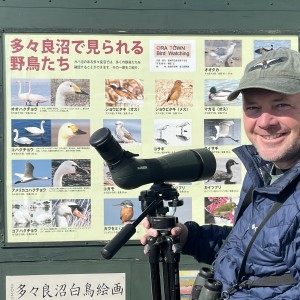
Bryan Shirley graduated from the University of Kentucky with a degree in Japanese/International Economics. He lived in Japan for 3 years when he was 20 and fell in love with the language and culture and has been guiding and birding there ever since. Besides guiding in Japan, he regularly leads tours for Japanese birding groups around the US and other countries. When not guiding he has been involved with various DWR and USFWS projects such as relocating Sage Grouse, breeding bird surveys, and bird-related projects for private environmental consulting firms. He also has volunteered his time to serve as president of Utah County Birders and organizes the annual Audubon Christmas Bird Counts for Provo and Payson, Utah where he currently resides. He currently is a member of the Utah Bird Records Committee.
Other trips with Bryan Shirley
-
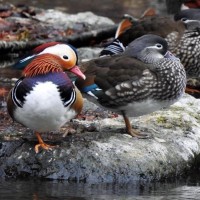 Japan Birding & Nature FULL - Check out Island of Wonder: Birds & Nature of Sri Lanka!January 7 - 23, 2026
Japan Birding & Nature FULL - Check out Island of Wonder: Birds & Nature of Sri Lanka!January 7 - 23, 2026 -
 Guyana: Unspoiled WildernessFebruary 12 - 24, 2026
Guyana: Unspoiled WildernessFebruary 12 - 24, 2026 -
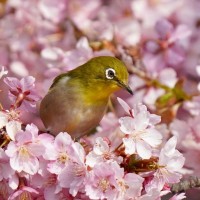 Spring in Japan: The Southern Islands FULL - Check out Island of Wonder: Birds & Nature of Sri Lanka!April 1 - 14, 2026
Spring in Japan: The Southern Islands FULL - Check out Island of Wonder: Birds & Nature of Sri Lanka!April 1 - 14, 2026 -
 Iceland Birding & Nature FULL - See our Austria & Hungary tour!June 6 - 16, 2026
Iceland Birding & Nature FULL - See our Austria & Hungary tour!June 6 - 16, 2026 -
 Japan Birding & Nature FULL - Check out Japan in December 2027!January 7 - 23, 2027
Japan Birding & Nature FULL - Check out Japan in December 2027!January 7 - 23, 2027 -
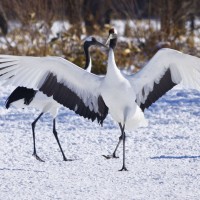 Japan Birding & Nature December 1 - 17, 2027
Japan Birding & Nature December 1 - 17, 2027 -
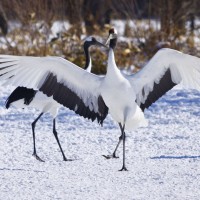 Japan Birding & Nature January 7 - 23, 2028
Japan Birding & Nature January 7 - 23, 2028
-
Essential Information +
Pace & Protocols +
Packing List +
Suggested Reading List +
Useful Links +
Photo credits: Banners: Elephant (Julie Morgan), Saddle-billed (Greg Smith), Giraffes under Baobab (Peg Abbott), Zebra Faces (Peg Abbott) Thumbnails: Yellow-collared Lovebird (Julie Morgan), Giraffe (Julie Morgan), Gray-headed Kingfisher, Gray-crowned Crane, Lion (Peg Abbott), Hartlaub’s Turaco (Peg Abbott), Collared Sunbird (Sherri Porter)






















